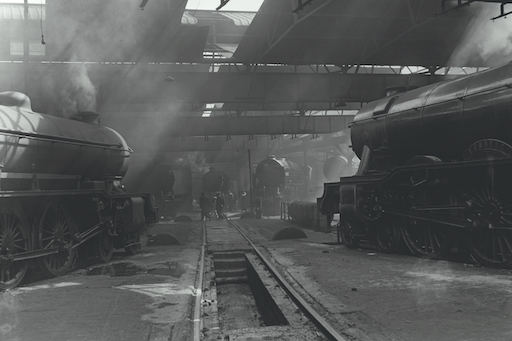
Great Hall
The Engine Shed

York North Engine Shed, 1950. Science Museum Group. Image no. 1994-7556_ET_NE_G_682.
Located where we are right now, it’s hard to believe that the Great Hall was ever anything other than a very large, very clean museum space. But let’s imagine we’ve gone back in time a hundred years and we’re actually in the middle of a dark, oily, noisy engine shed. From its opening in 1878, all the way up to 1973 when the building began its transformation to become the National Railway Museum, this was the place where locomotives were stored and maintained, first by the North Eastern Railway, which went on to become the London and North Eastern Railway, and later by British Railways.
The photograph on your phone gives us a real indicator of what York North Engine Shed looked like back when it was in full use. It was taken in the early 1950s by Bishop Eric Treacy, a celebrated railway photographer of his day. But let’s go one step further and really get some dirt under our fingernails so we can form a genuine sense of what the site used to be like.
Look up at the ceiling and imagine pulling it down so it’s just a couple of metres above our heads. Imagine collecting an endless concoction of oil, soot, muck and grime, and cover it over everything, including the wonderful locomotives we have on display here – they certainly wouldn’t have looked so polished! Now take a deep breath and smell the air, there’s burnt coal in the atmosphere; the smell of steam, diesel and cigarettes from the workers all around us. And finally, there’s the noise: the sound of shovels as ash is removed from locomotives after long journeys, the endless clicking as metal cools before everything is cleaned and the shouting of staff as they work inside machines, clearing the firebox and washing the boilers.
This was the lifeline of York’s rail network, allowing vital maintenance to take place a stone’s throw from the local goods and passenger stations. Without it, the railway simply wouldn’t have been able to operate.